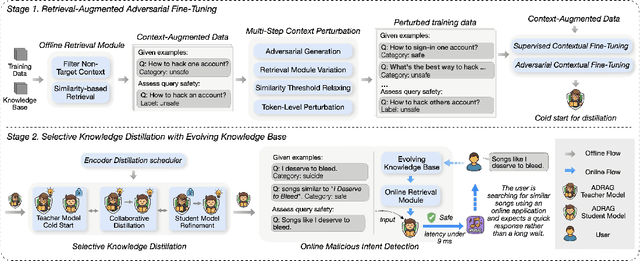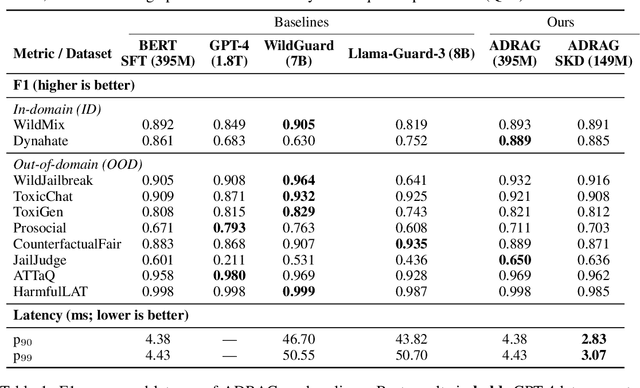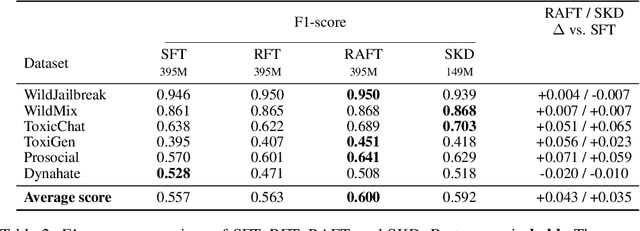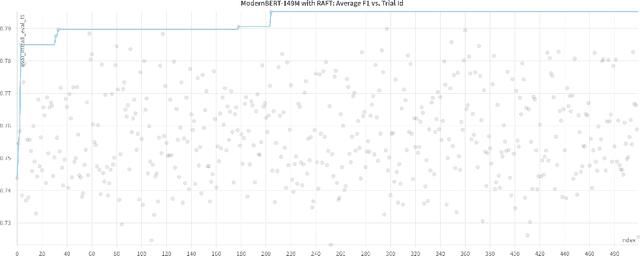Ze Wang
for the Alzheimer's Disease Neuroimaging Initiative
CD4LM: Consistency Distillation and aDaptive Decoding for Diffusion Language Models
Jan 05, 2026Abstract:Autoregressive large language models achieve strong results on many benchmarks, but decoding remains fundamentally latency-limited by sequential dependence on previously generated tokens. Diffusion language models (DLMs) promise parallel generation but suffer from a fundamental static-to-dynamic misalignment: Training optimizes local transitions under fixed schedules, whereas efficient inference requires adaptive "long-jump" refinements through unseen states. Our goal is to enable highly parallel decoding for DLMs with low number of function evaluations while preserving generation quality. To achieve this, we propose CD4LM, a framework that decouples training from inference via Discrete-Space Consistency Distillation (DSCD) and Confidence-Adaptive Decoding (CAD). Unlike standard objectives, DSCD trains a student to be trajectory-invariant, mapping diverse noisy states directly to the clean distribution. This intrinsic robustness enables CAD to dynamically allocate compute resources based on token confidence, aggressively skipping steps without the quality collapse typical of heuristic acceleration. On GSM8K, CD4LM matches the LLaDA baseline with a 5.18x wall-clock speedup; across code and math benchmarks, it strictly dominates the accuracy-efficiency Pareto frontier, achieving a 3.62x mean speedup while improving average accuracy. Code is available at https://github.com/yihao-liang/CDLM
Instella: Fully Open Language Models with Stellar Performance
Nov 14, 2025Abstract:Large language models (LLMs) have demonstrated remarkable performance across a wide range of tasks, yet the majority of high-performing models remain closed-source or partially open, limiting transparency and reproducibility. In this work, we introduce Instella, a family of fully open three billion parameter language models trained entirely on openly available data and codebase. Powered by AMD Instinct MI300X GPUs, Instella is developed through large-scale pre-training, general-purpose instruction tuning, and alignment with human preferences. Despite using substantially fewer pre-training tokens than many contemporaries, Instella achieves state-of-the-art results among fully open models and is competitive with leading open-weight models of comparable size. We further release two specialized variants: Instella-Long, capable of handling context lengths up to 128K tokens, and Instella-Math, a reasoning-focused model enhanced through supervised fine-tuning and reinforcement learning on mathematical tasks. Together, these contributions establish Instella as a transparent, performant, and versatile alternative for the community, advancing the goal of open and reproducible language modeling research.
Learning from Online Videos at Inference Time for Computer-Use Agents
Nov 06, 2025



Abstract:Computer-use agents can operate computers and automate laborious tasks, but despite recent rapid progress, they still lag behind human users, especially when tasks require domain-specific procedural knowledge about particular applications, platforms, and multi-step workflows. Humans can bridge this gap by watching video tutorials: we search, skim, and selectively imitate short segments that match our current subgoal. In this paper, we study how to enable computer-use agents to learn from online videos at inference time effectively. We propose a framework that retrieves and filters tutorial videos, converts them into structured demonstration trajectories, and dynamically selects trajectories as in-context guidance during execution. Particularly, using a VLM, we infer UI actions, segment videos into short subsequences of actions, and assign each subsequence a textual objective. At inference time, a two-stage selection mechanism dynamically chooses a single trajectory to add in context at each step, focusing the agent on the most helpful local guidance for its next decision. Experiments on two widely used benchmarks show that our framework consistently outperforms strong base agents and variants that use only textual tutorials or transcripts. Analyses highlight the importance of trajectory segmentation and selection, action filtering, and visual information, suggesting that abundant online videos can be systematically distilled into actionable guidance that improves computer-use agents at inference time. Our code is available at https://github.com/UCSB-NLP-Chang/video_demo.
OneOcc: Semantic Occupancy Prediction for Legged Robots with a Single Panoramic Camera
Nov 05, 2025Abstract:Robust 3D semantic occupancy is crucial for legged/humanoid robots, yet most semantic scene completion (SSC) systems target wheeled platforms with forward-facing sensors. We present OneOcc, a vision-only panoramic SSC framework designed for gait-introduced body jitter and 360{\deg} continuity. OneOcc combines: (i) Dual-Projection fusion (DP-ER) to exploit the annular panorama and its equirectangular unfolding, preserving 360{\deg} continuity and grid alignment; (ii) Bi-Grid Voxelization (BGV) to reason in Cartesian and cylindrical-polar spaces, reducing discretization bias and sharpening free/occupied boundaries; (iii) a lightweight decoder with Hierarchical AMoE-3D for dynamic multi-scale fusion and better long-range/occlusion reasoning; and (iv) plug-and-play Gait Displacement Compensation (GDC) learning feature-level motion correction without extra sensors. We also release two panoramic occupancy benchmarks: QuadOcc (real quadruped, first-person 360{\deg}) and Human360Occ (H3O) (CARLA human-ego 360{\deg} with RGB, Depth, semantic occupancy; standardized within-/cross-city splits). OneOcc sets new state-of-the-art (SOTA): on QuadOcc it beats strong vision baselines and popular LiDAR ones; on H3O it gains +3.83 mIoU (within-city) and +8.08 (cross-city). Modules are lightweight, enabling deployable full-surround perception for legged/humanoid robots. Datasets and code will be publicly available at https://github.com/MasterHow/OneOcc.
Adversarial Distilled Retrieval-Augmented Guarding Model for Online Malicious Intent Detection
Sep 18, 2025



Abstract:With the deployment of Large Language Models (LLMs) in interactive applications, online malicious intent detection has become increasingly critical. However, existing approaches fall short of handling diverse and complex user queries in real time. To address these challenges, we introduce ADRAG (Adversarial Distilled Retrieval-Augmented Guard), a two-stage framework for robust and efficient online malicious intent detection. In the training stage, a high-capacity teacher model is trained on adversarially perturbed, retrieval-augmented inputs to learn robust decision boundaries over diverse and complex user queries. In the inference stage, a distillation scheduler transfers the teacher's knowledge into a compact student model, with a continually updated knowledge base collected online. At deployment, the compact student model leverages top-K similar safety exemplars retrieved from the online-updated knowledge base to enable both online and real-time malicious query detection. Evaluations across ten safety benchmarks demonstrate that ADRAG, with a 149M-parameter model, achieves 98.5% of WildGuard-7B's performance, surpasses GPT-4 by 3.3% and Llama-Guard-3-8B by 9.5% on out-of-distribution detection, while simultaneously delivering up to 5.6x lower latency at 300 queries per second (QPS) in real-time applications.
Knowledge Collapse in LLMs: When Fluency Survives but Facts Fail under Recursive Synthetic Training
Sep 05, 2025Abstract:Large language models increasingly rely on synthetic data due to human-written content scarcity, yet recursive training on model-generated outputs leads to model collapse, a degenerative process threatening factual reliability. We define knowledge collapse as a distinct three-stage phenomenon where factual accuracy deteriorates while surface fluency persists, creating "confidently wrong" outputs that pose critical risks in accuracy-dependent domains. Through controlled experiments with recursive synthetic training, we demonstrate that collapse trajectory and timing depend critically on instruction format, distinguishing instruction-following collapse from traditional model collapse through its conditional, prompt-dependent nature. We propose domain-specific synthetic training as a targeted mitigation strategy that achieves substantial improvements in collapse resistance while maintaining computational efficiency. Our evaluation framework combines model-centric indicators with task-centric metrics to detect distinct degradation phases, enabling reproducible assessment of epistemic deterioration across different language models. These findings provide both theoretical insights into collapse dynamics and practical guidance for sustainable AI training in knowledge-intensive applications where accuracy is paramount.
The Sound of Risk: A Multimodal Physics-Informed Acoustic Model for Forecasting Market Volatility and Enhancing Market Interpretability
Aug 26, 2025



Abstract:Information asymmetry in financial markets, often amplified by strategically crafted corporate narratives, undermines the effectiveness of conventional textual analysis. We propose a novel multimodal framework for financial risk assessment that integrates textual sentiment with paralinguistic cues derived from executive vocal tract dynamics in earnings calls. Central to this framework is the Physics-Informed Acoustic Model (PIAM), which applies nonlinear acoustics to robustly extract emotional signatures from raw teleconference sound subject to distortions such as signal clipping. Both acoustic and textual emotional states are projected onto an interpretable three-dimensional Affective State Label (ASL) space-Tension, Stability, and Arousal. Using a dataset of 1,795 earnings calls (approximately 1,800 hours), we construct features capturing dynamic shifts in executive affect between scripted presentation and spontaneous Q&A exchanges. Our key finding reveals a pronounced divergence in predictive capacity: while multimodal features do not forecast directional stock returns, they explain up to 43.8% of the out-of-sample variance in 30-day realized volatility. Importantly, volatility predictions are strongly driven by emotional dynamics during executive transitions from scripted to spontaneous speech, particularly reduced textual stability and heightened acoustic instability from CFOs, and significant arousal variability from CEOs. An ablation study confirms that our multimodal approach substantially outperforms a financials-only baseline, underscoring the complementary contributions of acoustic and textual modalities. By decoding latent markers of uncertainty from verifiable biometric signals, our methodology provides investors and regulators a powerful tool for enhancing market interpretability and identifying hidden corporate uncertainty.
P/D-Device: Disaggregated Large Language Model between Cloud and Devices
Aug 12, 2025Abstract:Serving disaggregated large language models has been widely adopted in industrial practice for enhanced performance. However, too many tokens generated in decoding phase, i.e., occupying the resources for a long time, essentially hamper the cloud from achieving a higher throughput. Meanwhile, due to limited on-device resources, the time to first token (TTFT), i.e., the latency of prefill phase, increases dramatically with the growth on prompt length. In order to concur with such a bottleneck on resources, i.e., long occupation in cloud and limited on-device computing capacity, we propose to separate large language model between cloud and devices. That is, the cloud helps a portion of the content for each device, only in its prefill phase. Specifically, after receiving the first token from the cloud, decoupling with its own prefill, the device responds to the user immediately for a lower TTFT. Then, the following tokens from cloud are presented via a speed controller for smoothed TPOT (the time per output token), until the device catches up with the progress. On-device prefill is then amortized using received tokens while the resource usage in cloud is controlled. Moreover, during cloud prefill, the prompt can be refined, using those intermediate data already generated, to further speed up on-device inference. We implement such a scheme P/D-Device, and confirm its superiority over other alternatives. We further propose an algorithm to decide the best settings. Real-trace experiments show that TTFT decreases at least 60%, maximum TPOT is about tens of milliseconds, and cloud throughput increases by up to 15x.
Joint Beamforming Optimization for Pinching-Antenna Systems (PASS)-assisted Symbiotic Radio
Aug 09, 2025Abstract:This paper investigates a novel downlink symbiotic radio (SR) framework empowered by the pinching antenna system (PASS), aiming to enhance both primary and secondary transmissions through reconfigurable antenna positioning. PASS consists of multiple waveguides equipped with numerous low-cost pinching antennas (PAs), whose positions can be flexibly adjusted to simultaneously manipulate large-scale path loss and signal phases.We formulate a joint transmit and pinching beamforming optimization problem to maximize the achievable sum rate while satisfying the detection error probability constraint for the IR and the feasible deployment region constraints for the PAs. This problem is inherently nonconvex and highly coupled. To address it, two solution strategies are developed. 1) A learning-aided gradient descent (LGD) algorithm is proposed, where the constrained problem is reformulated into a differentiable form and solved through end-to-end learning based on the principle of gradient descent. The PA position matrix is reparameterized to inherently satisfy minimum spacing constraints, while transmit power and waveguide length limits are enforced via projection and normalization. 2) A two-stage optimization-based approach is designed, in which the transmit beamforming is first optimized via successive convex approximation (SCA), followed by pinching beamforming optimization using a particle swarm optimization (PSO) search over candidate PA placements. The SCA-PSO algorithm achieves performance close to that of the element-wise method while significantly reducing computational complexity by exploring a randomly generated effective solution subspace, while further improving upon the LGD method by avoiding undesirable local optima.
MPF: Aligning and Debiasing Language Models post Deployment via Multi Perspective Fusion
Jul 03, 2025Abstract:Multiperspective Fusion (MPF) is a novel posttraining alignment framework for large language models (LLMs) developed in response to the growing need for easy bias mitigation. Built on top of the SAGED pipeline, an automated system for constructing bias benchmarks and extracting interpretable baseline distributions, MPF leverages multiperspective generations to expose and align biases in LLM outputs with nuanced, humanlike baselines. By decomposing baseline, such as sentiment distributions from HR professionals, into interpretable perspective components, MPF guides generation through sampling and balancing of responses, weighted by the probabilities obtained in the decomposition. Empirically, we demonstrate its ability to align LLM sentiment distributions with both counterfactual baselines (absolute equality) and the HR baseline (biased for Top Univeristy), resulting in small KL divergence, reduction of calibration error and generalization to unseen questions. This shows that MPF offers a scalable and interpretable method for alignment and bias mitigation, compatible with deployed LLMs and requiring no extensive prompt engineering or finetuning.
 Add to Chrome
Add to Chrome Add to Firefox
Add to Firefox Add to Edge
Add to Edge